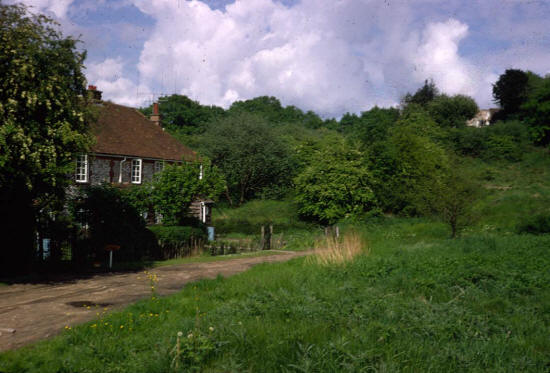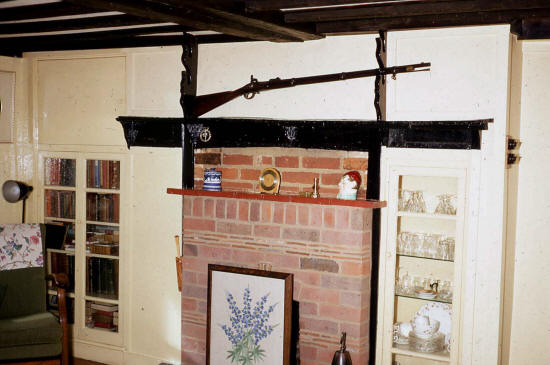A History of Frieth |
1800 - 1860 |
|
Preface |
These were hungry years for England as a whole and the poverty was something we find hard to imagine.
Fortunately for Frieth, this is the point in our Village story when two remarkable men came upon the scene, and who had a great influence on the lives of the people
and the welding of the scattered communities into a village. These two men were Rectors of Hambleden and were father and son.
The father, the Rev. Henry Colborne Ridley 1803-1832 and the son, the Rev. William Henry Ridley 1840-1882. They devoted their lives to their parishioners helping them
in body and soul through the hungry years. If you wish to read more about them, their story is well told in Rev. Stanton's book "On Chiltern Slopes".
H.C. Ridley wrote letters to his "wife-to-be" and papers on his parochial duties - Rev. Stanton had access to all these letters and papers together with all the
Hambleden Parish Records and from his book we can get an idea of what life was like in Hambleden, and Frieth to some extent.
Before 1848 there was no church building in Frieth, so religious services were held on different days of the week in cottages and on Sunday the congregation walked to Hambleden and stayed for the whole Sunday. Most people were illiterate so H.C. Ridley set up a Sunday School and a Night School. He collected a small lending library and sold Bibles and tracts. As well as overseeing education he attempted to help the sick, he kept a well stocked medicine chest, bed linen was loaned for sickness and other bedding bundles in time of child-birth. He set up a clothing room for poor persons and organised distributions of wood and potatoes. Later he started a Savings Scheme and a branch of the Bucks Friendly Society in an effort to help his parishioners help themselves; and, in this same vein, he fostered the Lace Trade. By collecting and selling pillow lace for cottagers the Ridleys helped them raise their income. Lace was well paid for at the beginning of the 19th century but the price dropped sharply as machine made lace took over. During the first half of the 19th century Lace Schools were set up in Frieth, an older woman would have small girls with their pillows around her and teach them the intricate patterns, also, she would (if able) teach the rudiments of reading and counting to girls and small boys. (see Miss West's description of Pillow Lace Making in Frieth). A.H. Stanton also tells of the disastrous cholera epidemic of 1830. H.C. Ridley took his wife and young family away from Hambleden village, where cholera was raging, to the comparative safety of Lane End (although later he died of the disease). He writes that at the time he found Lane End "quite heathen" and set wheels in motion to build a church there, but he did not live to see it built. This is the first mention I have made of Lane End, in fact there appears to have been very little connection between Frieth and Lane End, the road between the two, as we know it today, did not exist. In fact as late as 1840 there was no road down Frieth Hill, only a track on a grassy slope. This continued across the common as a path only. Another track to Lane End ran in front of the Folly Cottages and up the common towards Lane End passing behind the group of cottages on the sharp corner opposite the end of Moor Farm drive.  The old road going past Folly Cottages  View from the old road looking in the direction of Fingest c1918 (Dover's Farm middle distance) [ From the collection of James Bowley October 2020 ] Then the road went on in front of the cottages adjoining Silva's Garage [Clinkard Place is now where Silva's Garage once was] and up to the 'Jolly Blacksmith', passing this on the left and on to Lane End emerging between the Village Hall and Daisy Cottages.  The old road going towards the Jolly Blacksmith (rh edge of pcture) Probably due to the large area of common land between them and the fact that they lay in different parishes, the two villages appear to have developed quite independently and there was even some antipathy between the two, this was broken down to some extent later in the century when the Cripps family owned land in and around both villages. But what was life like in a cottage in Frieth during the early years of the 19th century? Little Cottage on Frieth Hill was then the cowman's cottage for Barlows Farm and was a typical example of a cottage of that date. On the ground floor was one large room with a huge open fireplace, chimney corner seats on either side, a spit-rack above, and a bread oven to one side.  Spit Rack above the fireplace at Little Cottage This bread oven was brick built and hemi-spherical in shape, it was simply heated by pushing a faggot of wood in through the small door on the fire side, lighting it and allowing the wood to burn itself out. Then the ashes were raked out through the same door and the bread put in to cook on the hot bricks.  Chimney corner seats in the fireplace at Shogmore Farm The main room had a tile or sometimes even an earth floor. In the evening it was lit by rush light or tallow candles. In this house were two other small rooms of about equal size. The first, a store room, had a long plank shelf wide enough to salt a side of bacon and a space under to store crocks of flour, potatoes and dried peas. Above hung dried herbs and in the corner stood a pitcher of milk. Ale and beer were the common drink, this would be brewed locally. Fresh meat was shared out when an animal was killed. Farmers kept cows and sheep but the cottager kept his pig and when this was killed nothing was wasted, not even the chittlings! [ My father used to say that you could eat every part of a pig except the squeal! ] Occasionally meat was roasted on a spit but usually cooking was done in a pot over the fire, everything was put in together, water, potatoes in a net, a pudding made with suet or lard, herbs and a piece of bacon. The third room downstairs was the wash house and here was a stone sink and a copper. The stairs went up from the main room and were shut off by a door. They led on to an open landing bedroom where the children slept and leading off this was a large bedroom lit by one small window. Cottages were overcrowded for families were large but, mercifully perhaps, a high infant mortality rate mitigated the high birth rate. Disease came, not surprisingly, spread by the proximity of earth closet and shallow water supply, but even so conditions in the country were not as bad as in the towns. Farm workers wore smocks and this type of clothing lingered later here than in many other parts of England. Clothes were home made but it was likely that cloth was purchased from a higgler (travelling salesman) at this date. Shoes were made by the village shoemaker. Between 1800 and 1860 Frieth was a farming community. The men were farmers or farm-labourers. The women supplemented their income by lace-making. The younger sons and daughters tended to seek work elsewhere. Women and children went wooding (gathering fallen branches for firewood during the permitted season) leasing (gleaning after the reapers) and stone picking (for road making and house building) to help increase their income. Children who were old enough helped work on the farms or minded cows, sheep and geese on the common. Most cottages had a small vegetable garden and some kept bees. The 1841 Census returns show that there were: 12 families living in Great Frieth, 13 in Little Frieth, 10 at Moor's End, 8 at Spurgrove and 3 at Perrin Spring. In all 215 people in 46 families. [ The best map from this period is the 1845 Tithe Map of Hambleden Parish showing the landowners and occupiers Frieth part of the map ] In 1848 Canon Ridley had Frieth Chapel (as it was called) built. Stones were carted by Frieth and Hambleden farmers from a demolished wing of the old Rectory at Hambleden. This was the turning-point in welding the five communities into a village.  In 1865 Frieth School was built. See A History of Frieth School 1865 - 1985 A breakdown of the Census figures for 1851 gives an interesting picture. By 1851, 304 persons lived in Frieth (this included Ackhampstead - see Dr. Wyatt's 'History of Ackhampstead'. This Census includes some detail of the place of birth of the inhabitants and their occupations, so we know: 214 were born in the Parish of Hambleden 8 in Lewknor (Ackhampstead) 10 in Fingest 6 in Turville 7 in Medmenham, Marlow or Henley 6 in High Wycombe 37 in other parts of Bucks, Berks or Oxon 5 in London 1 in Ireland ! 85 were Agricultural Labourers 59 were Lace-makers 1 farmer of 9 acres (Spurgrove) 1 farmer, publican and baker -14 acres at Great Frieth (Yew Tree) 1 farmer and publican - 9 acres at Great Frieth (Barlows) Other trades listed were carpenter, gardener, groom, brickmaker, cordwainer, higgler, chairmaker, sawyer, seamstress, schoolmistress (dame), road surveyor, glazier and grocer. This gives a picture of a small self-supporting community. |
